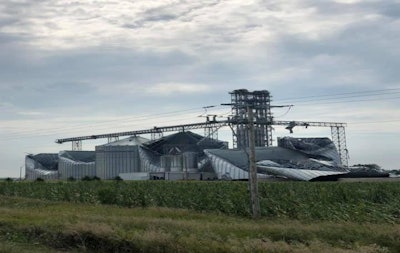
The perfect storm that has been 2020 continues, and this time it is actually weather-related.
Most of Iowa seemed to be back to normal as restrictions related to the COVID-19 pandemic have been lifted, but now many are limited due to a lack of power and storm damage, especially in rural areas, as catastrophic storms hit the state Monday afternoon.
According to The Weather Channel, "a derecho raced eastward across the Midwest on Monday, Aug. 10, 2020, where it caused widespread damage to trees, structures and knocked out power to more than one million."
A derecho is a widespread, long-lived, straight-line windstorm that is associated with a fast-moving group of severe thunderstorms known as a mesoscale convective system. Derechos can cause hurricane-force winds, tornadoes, heavy rains, and flash floods. This storm spread over multiple states in the Midwest, with Iowa taking the brunt of it.
"Multiple locations in Iowa clocked wind gusts of 90 mph or greater, including a gust to 112 mph in Midway," the same report said. Iowa Gov. Kim Reynolds issued a disaster proclamation for 23 counties heavily impacted by the derecho.
KCCI Des Moines reported that according to Reynolds, early estimates indicate that 10 million acres of farmland was flattened. “Reynolds said during her Tuesday news conference that the state estimates at least one third of Iowa crops sustained damage during the severe storms,” the report said. Some reports are even saying as much as 43% of the state's corn and soybean crops were damaged.

Corn down just east of Cedar Rapids, Iowa. | Matt Rogers
According to AP News, “Before the storm hit, the U.S. Department of Agriculture had been expecting a record national corn crop this year of 15.3 billion bushels harvested from about 84 million acres. Iowa was to provide about 18% of that production.”
“State Ag Secretary Mike Naig said some of the corn that was flattened by Monday’s storm will bounce back, but it’s anybody’s guess as to what percentage of damaged Iowa crops may be harvested,” Iowa Radio reported. Grain bins, silos and elevators were damaged as well, so losses extend to the 2019 crop, the same report explained.
“Tens of millions of bushels of commercial grain storage and millions of on-farm grain storage was impacted, destroyed or severely damaged,” he said during an online briefing with reporters Tuesday afternoon, the Iowa Radio report said.
This could create a storage shortage for the upcoming crop. Naig explained that farmers may have to truck their corn and soybeans further or resort to on-the-ground outdoor storage as a result, the Iowa Radio report explained.

Grain bin damage in DeWitt, Iowa. | Jenifer Blanchard
Personal experience
Our operation was certainly no exception to the abundance of farms that were impacted. Aside from not having any power or water (at first), we lost a small shed, part of a roof on one of our barns, multiple trees and fences, and some of our corn is down; but trust me when I say that is very minor to what many are dealing with.
The electric company is saying it will be at least a week before we have power, so we have been running generators to keep the well running, allowing us to water cattle. People are driving over an hour to get gas to refill generators.
Social media is full of pictures that are simply heartbreaking. While those in urban areas are experiencing significant material loss, that I am by no means downplaying, those in rural areas lost their source of income and material items that in some cases impact their revenue.
A woman on Facebook said it best, "Iowa is number one in corn, soybean, hog and egg production, and top 5 for red meat. We have experienced substantial damage to outbuildings, livestock facilities, and critical infrastructures such as grain bins and local elevators. This is not to mention the fact that many of our crops are now steamrolled flat, in a year where the markets were already at an all-time low and as yields were already cut by drought in many areas."
Iowa farmers needed rain, but certainly not like this.
While I didn’t hear of any major poultry farm losses within the state, I know several hog farmers that lost buildings and spent hours trying to save hogs still inside.
This is all after the pandemic that already created significant issues for farmers and livestock producers.
Let us not forget what this is probably doing to restaurant owners who were shut down by the state and now that they reopened within Iowa they may be without power or may have lost product that was in the freezers.
Grocery stores are closed due to power limitations. Phone towers were down, and people were limited in their ability to call for help. Homes are gone or not suitable for living.
This is a devastating time for Iowa, but especially for its farmers. The only positive is watching rural communities, like my own, come together to help one another.

















